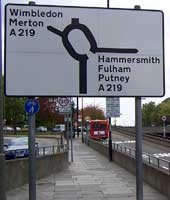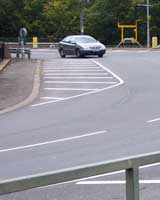
Think of a roundabout and you'll inevitably think of a circle. But actually, many roundabouts aren't circular at all: there are an awful lot that are elliptical or some other lumpy variation on the perfect circle, and others that are quite wilfully angular, all straight lines and sharp corners.
The reason is simple enough. Over the years the optimum design for a roundabout - its geometry, layout, width, radius, entry and exit angle, deflection and more - has been the subject of academic theory and engineering experiment. We're left with a legacy of roundabouts of countless interesting shapes and sizes.
Straight lines and sharp corners
From the 1940s until the 1970s, there was a fairly influential school of thought that roundabouts shouldn't be round at all. While a traditional circular junction would involve a sweeping set of curves left, right, left that all flowed together, some engineers preferred clearly defined corners and straight sections.
They are sometimes referred to as "squareabouts" for obvious reasons, and square is the normal shape, but actually this type of design tended to insert a corner at every connecting road and a straight in between each one. The effect was that, at every point where vehicles joined, both streams of converging traffic were slowed by a corner. This was especially desirable on pre-sixties roundabouts on which nobody had priority and careful merging was the order of the day.
Some of the earliest proposals of this type of junction are found in the wartime reconstruction bible, the County of London Plan 1943, which sets out standard types of road junction to be adopted on the world-class highway network that we never ended up building. Amongst its words of advice are an awful lot of sharp-cornered rotaries, and in its detailed area plans, every one of London's headache inducing multiple-road junctions is equipped with a spiky and unique angular roundabout.

It's unusual to see a roundabout redesigned, and so we are left with an awful lot of squares, hexagons and other angular road layouts across the country. Some have seen their shape define them, like the Pentagon in Derby. You can often find them over and under 1960s flyovers. There's a matching pair beneath the Mancunian Way in Manchester, for example; a downright rectangular one at Tibbett's Corner on the A3 (left; click to enlarge), and there was once a very sharply triangular one at Elephant and Castle in South London.
Over time the call for corners became less convincing. With a priority-to-the-right system in place, circulating traffic didn't have to slow down; in fact forcing it to do so would increase waiting times for traffic on the approaches. Moreover, those theoretically-organised designs were actually proving uncomfortable to drive and were making it unnecessarily difficult for traffic to stay in lane as it swerved around. Times were changing, and the squareabout was out.
All shapes and sizes

By the late sixties, engineers were starting to look at the benefits that a roundabout could bring (complete with that groovy new priority rule) and ask how they could be applied to junctions without enough room for a full roundabout. For a time, the Ministry of Transport considered applying roundabout rules without any roundabout at all, dreaming up the "pivot junction" and even designing a road sign for it (shown right; click to enlarge). Thankfully it was never used.
The answer, proposed by the Road Research Laboratory, was the mini roundabout: a small painted island that would introduce the priority-to-the-right rule to any road junction, in which the physical roundabout was only really present to make it clear to drivers how they should behave. By 1971 there were some 33 in operation, and they have been growing in number ever since.

Today the mini roundabout lives in disgrace as, thanks to its use during the 1980s and 90s, many drivers lump it in as "traffic calming", along with such objects of contempt as speed bumps and chicanes. This really isn't fair: a mini roundabout is often the perfect fix for a difficult junction where there is a roughly equal volume of traffic on each approach and it can handle surprisingly large volumes of traffic - if you give it the chance.
Mini roundabouts led on to "small roundabouts", on which it was observed that a central island of 3m (10ft) diameter performed substantially better than a more traditional large roundabout, and small roundabouts then led RRL researchers on to ring junctions - or, to you and me, Magic Roundabouts.
New discoveries and innovations aside, though, roundabout design was about to come, er, full circle. (Sorry.)
Perfection through deflection
In a way, we're back to square one with roundabout design. Fashions have come and gone for squares and angles, small islands and no islands, enormous sweeping racetracks, and peculiar gyratories hammered together from existing streets and squares. Not any longer. No, today we're back at a nice moderately-sized roundabout that is perfectly circular. Plus ça change and all that.
There's more to it than that, of course. Design practice now does prefer a circular roundabout unless there's a good reason to use something else, making journeys through the junction flow smoothly through left, right, left again. But the key now is not shape but deflection.
Deflection is the angle at which you enter and exit the roundabout. Ideally you should approach it head-on and then curve left at the last moment, forcing you to slow down and discouraging you from ploughing straight on to the junction. The exit, on the other hand, should be smoother, curving left out of the roundabout and straightening up to match acceleration away from the junction.
It's not easy to get right, and it's noticeable when it's missing. Some early roundabouts, for example, will force you on and off the junction at the same angle, which makes either the entry too fast or the exit too tight. Across much of the New Town of Stevenage, the roundabouts appear to have been designed for conversion to right-hand driving, because the deflection appears to be all the wrong way around.
Because of the nature of this type of junction, every roundabout is unique: it depends on the type of roads that it connects, the angle at which they approach, the space available, the flows of traffic expected, the pedestrian provision necessary and a hundred other fiddly factors. That means it depends heavily on the skill of the designer. Today we've got the roundabout more or less sorted: not too fast, not too slow, not too smooth, not too uncomfortable, and if you get one competently designed, it should be rather nice to drive around.
Maybe that's why we get a bit obsessive about them...
Picture credits
- Plan showing pentagonal and hexagonal roundabouts extracted from the County of London Plan (1943), now out of copyright.



